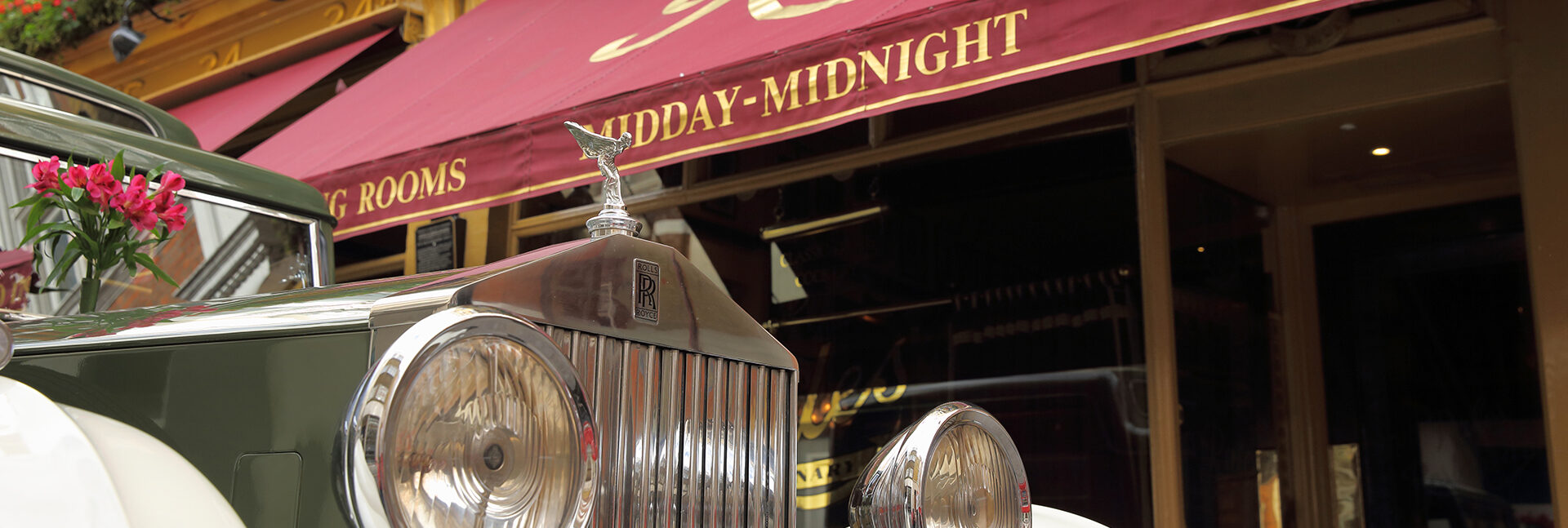Where should you eat with people to whom you have little to say? One lunchtime last week, i watched with interest as a lone British businessman introduced his two taciturn Japanese guests to Rules. “There’s a history of the restaurant here,” he said, handing them each a table-yop leaflet, Rules – A history of London’s oldest restaurant. Understandably, the leaflet tends to turn a blind eye to some of the shiftier aspects of the restaurant’s past. Notably absent is any reference to Edward V!! succumbing to a dodgy oyster at Rules, a mishap that caused the restaurant to be blackbaaled by soceity for more than a decade. Nor is there any quotation from the Rules passage in The End of the Affair. “Food interrupted our dreary small-talk,” is the best that Greene’s hero can say about his visit, but then one would hardly expect a Greene hero to crow: “And with a merry whoop we both agreed that the potted shrimps were simply to die for!”
After a prolonged reading of the leaflet (“Greene chose to spend all his birthdays in his quintessentially British surroundings of Rules…”) the businessman and his Japanese guests were able to divert their attention away from the pitfalls of conversation to a perusal of the higgledy-piggledy glories of the decor: portraits of mustachioed men, caricatures of virtually everyone from Queen Victoria to D.H.Lawrence, hunting prints, landscapes, architectural drawings, statuettes, clocks, lamps, stained glass, busts and a splendid array of antlers fill every nook and cranny. Unlike newer establishments, which tend to display the few knick-knacks they have on empty walls under multiple spotlights. Rules displays its bottomless stock of treasures any-old how. The ground floor remains exactly as it was – grand yet cosy, quaint yet not arch – when first I had visited it almost 20 years ago, and not that different. I suspect from 20, 50, 100 years before then.
Of course, like the Cabinet and television and the Top Ten and the village pub, Rules is one of those institutions that is always being charged with not being what it was. To a small extent this is true, but a good few of the changes have been for the better. For instance, I remember Rules in the mid seventies as being horribly expensive. The main change seems to be the age of the staff. I remember being served by men of a great age and greater seriousness such as might, in another life, have opened the front door with a welcoming grunt to indswept travellers at the country mansion of Count dracula. Now, alas, they have been replaced by bright young men and women who, for all their good humour and efficiency, are of a type currently appearing in almost every other restaurant in Covent Garden.
The two young waiters who served our table were both American, and although their un-English – or perhaps over-English – zeal (” I thank you very much’, I hope you have a good afternoon,”) was admirable, I still felt a pang of nostalgia for the crusty old gents of yesteryear. This vague sense of youthful revolution (was this what it was like to be in the Paris of 1968?) gains further eerinessby electronic order pads carried in specially designed holsters attached to the waiters’ buttocks, lending an unexpected Clint Eastwood aspect to the proceedings.
On the other hand, at least such offbeat intrusions of modernity prevent Rules from sinking to museum status, being cordoned off with a booth and a souvenir shop (“Historic Graham Greene Luxury Tartan Moist Wipes”) for the greater glory of English heritage.
Certainly, the food, which could so easily be ye olde pub grubbe, is well up to scratch, and sometimes way beyond it. There are one or two nods to the foreign or faddish (aubergine lasagne for instance) but by and large they serve generous portions of fresh, recognisably English food cooked with great aplomb and a minimum of high jinks. The only obvious omission lies in the savoury department, but perhaps it is asking too much of an American waiter in an English restaurant to explain Welsh rarebit to Japanese businessmen.
One of my gang kicked off with Oysters Rockefeller, with spinach, parmesan, pernod and cream. “it sounds disgusting but is really rather good,’ he said. “i almost feel as if I’m on the Queen mary in 1931.” I had a pleasantly bitty grouse terrine which was given a happy sweet-and-sour taste by a splodge of quince jelly. My other companion had good old potted shrimps, as rare on a menu in the present climate as bread-and-dripping or consomme of baby seal.
Main courses went down equally well. From the section on the menu somewhat off-puttingly titled “Furred game” (there is barely a bird in the sky unrepresented in the “Feathered Game section). I had wild highland red deer, which was marvellously rich without any of the hoofiness one usually associates with venison. My companions had a huge and delicious grouse, steak and mushroom pie, which came with excellent pastry and an equally fine steak and kidney pudding – with first rate mash.
Puddings are such as one used to find in gentlemen’s clubs before their members began to play squash at lunchtime and thus fall prone to heart attacks: treacle sponge puddings and custard, sticky toffee pudding, ice-cream and butterscotch sauce, and so forth, all spot on. As lunch dribbled to a close, we slumped back in our leather chairs two stone heavier and correspondingly cheerier. Glancing over in the direction of the Japanese businessmen and their Britih host, I was pleased to note that they too were now chatting away very merrily, as happy as sandboys.

